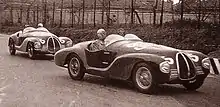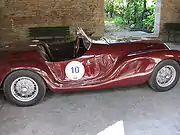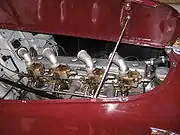Auto Avio Costruzioni 815
The Auto Avio Costruzioni 815 was the first car to be fully designed and built by Enzo Ferrari. Legal issues with former associates Alfa Romeo prevented Ferrari from creating the Ferrari marque. The 815 raced at the 1940 Brescia Grand Prix, where both entries failed to finish due to engine problems. One of the cars was later scrapped, while the other is currently in a car collection in Italy.
| Auto Avio Costruzioni 815 | |
|---|---|
 | |
| Overview | |
| Manufacturer | Auto Avio Costruzioni |
| Production | 1940 2 produced |
| Assembly | Modena, Italy |
| Body and chassis | |
| Class | Sports car |
| Body style | 2-seat barchetta |
| Powertrain | |
| Engine | 1.5 L (1496 cc) OHV I8 |
| Dimensions | |
| Wheelbase | 2,420 mm (95.3 in) |
| Curb weight | 625 kg (1,378 lb) |
| Chronology | |
| Successor | Ferrari 125 S |
Background
In 1938, Ferrari left Alfa Romeo after running Scuderia Ferrari as their racing division. The agreement ending their association forbade Ferrari from restarting Scuderia Ferrari within the next four years. Ferrari then founded Auto Avio Costruzioni (AAC) in Modena to manufacture aircraft parts and machine tools for the Italian government.[1] AAC specialized in the production of hydraulic grinding machines used to produce ball bearings. The company established business partnerships with other Italian firms, including Compagnia Nazionale Aeronautica and Piaggio.[2]
In December 1939, AAC was commissioned by Lotario, Marquis di Modena, to build and prepare two racing cars for him and Alberto Ascari to drive in the 1940 Mille Miglia. The race, which was officially named the Grand Prix of Brescia, was to be run in April 1940.[1] The resulting car was named the AAC Tipo 815.[3]
Details
The 815 was designed and developed by ex-Alfa Romeo engineers Alberto Massimino and Vittorio Bellentani and by Enrico Nardi.[1] The designation "815" was based on the car's eight-cylinder, 1.5 L engine.[1][3] This engine was largely based on the four-cylinder, 1.1 L engine of the Fiat 508 C Balilla 1100.[1][4] In concept, it was two 508C engines placed end to end, but it used a specially designed aluminium block built by Fonderia Calzoni in Bologna for integrity and light weight and a five-bearing crankshaft and a camshaft designed and built by AAC to get the traditional straight-8 timing and balance. The engine used Fiat valve gear, cylinder heads (two 508C heads per engine), and connecting rods.[1] The engine was high-tech for the time, with a single camshaft in block, two valves per cylinder, and a semi-dry sump lubrication system.[4] Four Weber 30DR2 carburettors were specified[1][4] for a total output of 75 hp (56 kW) at 5500 rpm.[1]
The 815 used a Fiat four-speed transmission with the Fiat gears replaced by gears made in-house by AAC.[1] The transmission was integral to the engine block.[4] The car had independent Dubonnet suspension with integral shock absorber at front, with a live axle on semi-elliptic leaf springs and hydraulic shock absorbers at the rear.[1]
As Mille Miglia regulations required that racing car chassis be based on production models, the AAC 815's chassis was also derived from the Fiat 508 C Balilla.[5]
The bodywork was done by Carrozzeria Touring using Itallumag 35, an aluminium/magnesium alloy,[1] and was done in long, flowing forms with integrated wings.[4] The bodywork weighed 119 lb (54 kg).[1] The complete car weighed 625 kg (1,378 lb) and attained a maximum speed close to 170 km/h (110 mph).[4]
Performance at 1940 Brescia Grand Prix

Two 815s, numbers 020 and 021, were completed and entered in the 1940 Brescia Grand Prix, which ran nine laps of a 103 miles (166 km) street circuit. Rangoni and Nardi raced in 020, while Ascari and Giuseppe Minozzi raced in 021. After leading the 1500 cc class in the first lap, Ascari's car developed valve problems and broke down. Rangoni then took the lead, set the lap record for the class, and had a lead of more than half an hour when his engine failed after seven laps.[1]
After the Second World War
Car no. 020 was sent to a scrapyard by Lotario Rangoni in 1938, following an accident. Lotario died during the Second World War and his brother, Rolando, inherited the car. Rolando attempted to recover the car from the scrapyard in 1958. After locating the car and confirming its identity with Enzo Ferrari, he returned to collect it only to find it had been crushed during his absence, irreversibly destroying it.[2][1][4]
Ascari's car, no. 021, was sold to racer Enrico Beltracchini[1][4] who raced it in 1947.[1] After selling the car to a museum and then buying it back, Beltracchini sold it again to Mario Righini.[1] As of 2020, Type 815 no. 021 was still in Righini's collection, housed at Anzola dell'Emilia near Modena.[2]
- Auto Avio Costruzioni 815
 AAC tipo 815 at the Panzano Castle 2009
AAC tipo 815 at the Panzano Castle 2009 Fiat-based engine in the AAC tipo 815.
Fiat-based engine in the AAC tipo 815.
References
- Hill, Phil (January 1992). Bryant, Thos. L (ed.). "Salon: The First Ferrari". Road & Track. Newport Beach, CA USA: Hachette Magazines. 43 (5): 96–99.
- Borgomeo, Vincenzo (14 April 2020). "Ferrari Number Zero". The Official Ferrari Magazine. Retrieved 2020-04-30.
- Yates, Brock (1991). Enzo Ferrari: The Man, the Cars, the Races. Doubleday. ISBN 0-385-26319-8.
- Acerbi, Leonardo (2012). Ferrari: All The Cars. Haynes Publishing. ISBN 978 1 84425 581 8.
- Whitcombe, Charis (28 July 2015). "Auto Avio Costruzioni 815, the 'secret' first Ferrari". www.classicdriver.com. Retrieved 2020-04-30.
- Acerbi, Leonardo (2012). Ferrari: All The Cars. Haynes Publishing. ISBN 978 1 84425 581 8.
External links
 Media related to Auto Avio Costruzioni 815 at Wikimedia Commons
Media related to Auto Avio Costruzioni 815 at Wikimedia Commons